Energy Audit Report: Analysis of a Custom Hotel in Glasgow, UK
VerifiedAdded on 2020/04/15
|19
|2584
|118
Report
AI Summary
This report presents an energy audit of a custom 12-story hotel building in Glasgow, evaluating its energy consumption patterns and costs. The analysis covers various aspects of the building, including lighting, HVAC systems, plumbing, and the building envelope. The report examines electrical energy and natural gas usage, identifying peak demand periods and consumption costs. It calculates heat loss through fabric and ventilation, and considers casual heat gains. Furthermore, the report investigates the potential of on-site renewable energy sources such as solar PV, wind turbines, and biomass boilers, discussing their advantages and limitations. The findings propose various energy-saving measures and sustainable design strategies, including better insulation, increased use of natural light, efficient thermostats, and energy-saving devices, to offset running costs. The report concludes with recommendations for optimizing energy efficiency and reducing environmental impact, supported by references to relevant literature.
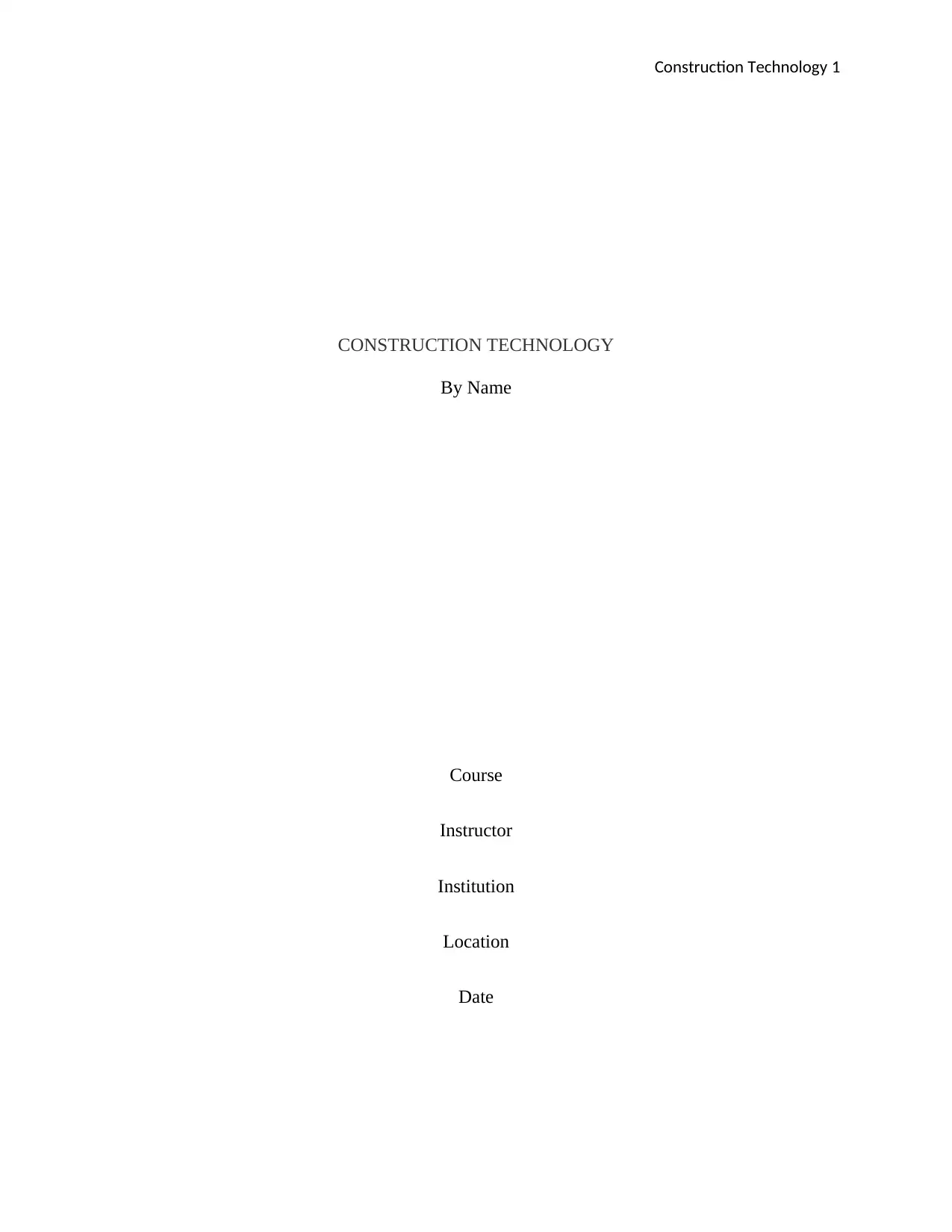
Construction Technology 1
CONSTRUCTION TECHNOLOGY
By Name
Course
Instructor
Institution
Location
Date
CONSTRUCTION TECHNOLOGY
By Name
Course
Instructor
Institution
Location
Date
Paraphrase This Document
Need a fresh take? Get an instant paraphrase of this document with our AI Paraphraser
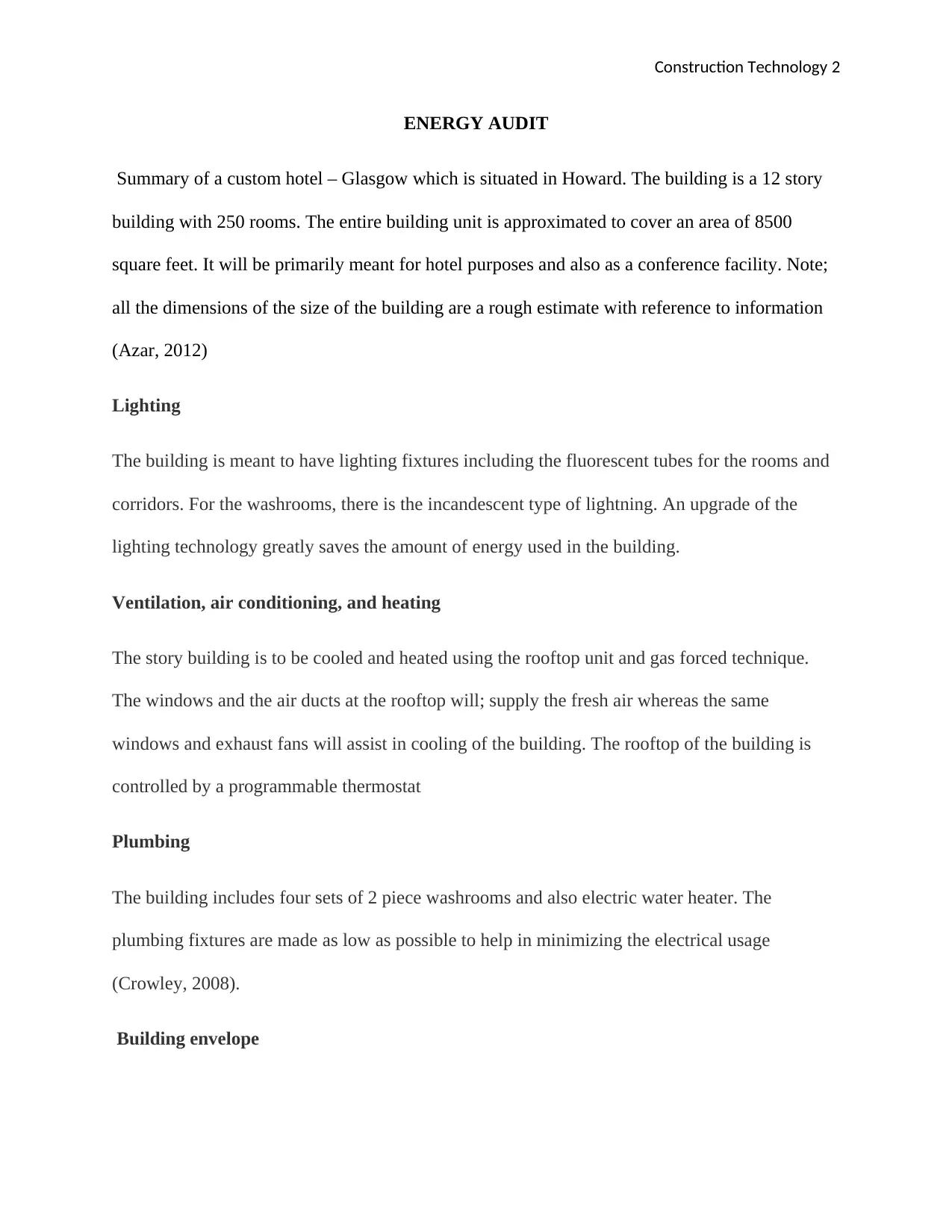
Construction Technology 2
ENERGY AUDIT
Summary of a custom hotel – Glasgow which is situated in Howard. The building is a 12 story
building with 250 rooms. The entire building unit is approximated to cover an area of 8500
square feet. It will be primarily meant for hotel purposes and also as a conference facility. Note;
all the dimensions of the size of the building are a rough estimate with reference to information
(Azar, 2012)
Lighting
The building is meant to have lighting fixtures including the fluorescent tubes for the rooms and
corridors. For the washrooms, there is the incandescent type of lightning. An upgrade of the
lighting technology greatly saves the amount of energy used in the building.
Ventilation, air conditioning, and heating
The story building is to be cooled and heated using the rooftop unit and gas forced technique.
The windows and the air ducts at the rooftop will; supply the fresh air whereas the same
windows and exhaust fans will assist in cooling of the building. The rooftop of the building is
controlled by a programmable thermostat
Plumbing
The building includes four sets of 2 piece washrooms and also electric water heater. The
plumbing fixtures are made as low as possible to help in minimizing the electrical usage
(Crowley, 2008).
Building envelope
ENERGY AUDIT
Summary of a custom hotel – Glasgow which is situated in Howard. The building is a 12 story
building with 250 rooms. The entire building unit is approximated to cover an area of 8500
square feet. It will be primarily meant for hotel purposes and also as a conference facility. Note;
all the dimensions of the size of the building are a rough estimate with reference to information
(Azar, 2012)
Lighting
The building is meant to have lighting fixtures including the fluorescent tubes for the rooms and
corridors. For the washrooms, there is the incandescent type of lightning. An upgrade of the
lighting technology greatly saves the amount of energy used in the building.
Ventilation, air conditioning, and heating
The story building is to be cooled and heated using the rooftop unit and gas forced technique.
The windows and the air ducts at the rooftop will; supply the fresh air whereas the same
windows and exhaust fans will assist in cooling of the building. The rooftop of the building is
controlled by a programmable thermostat
Plumbing
The building includes four sets of 2 piece washrooms and also electric water heater. The
plumbing fixtures are made as low as possible to help in minimizing the electrical usage
(Crowley, 2008).
Building envelope
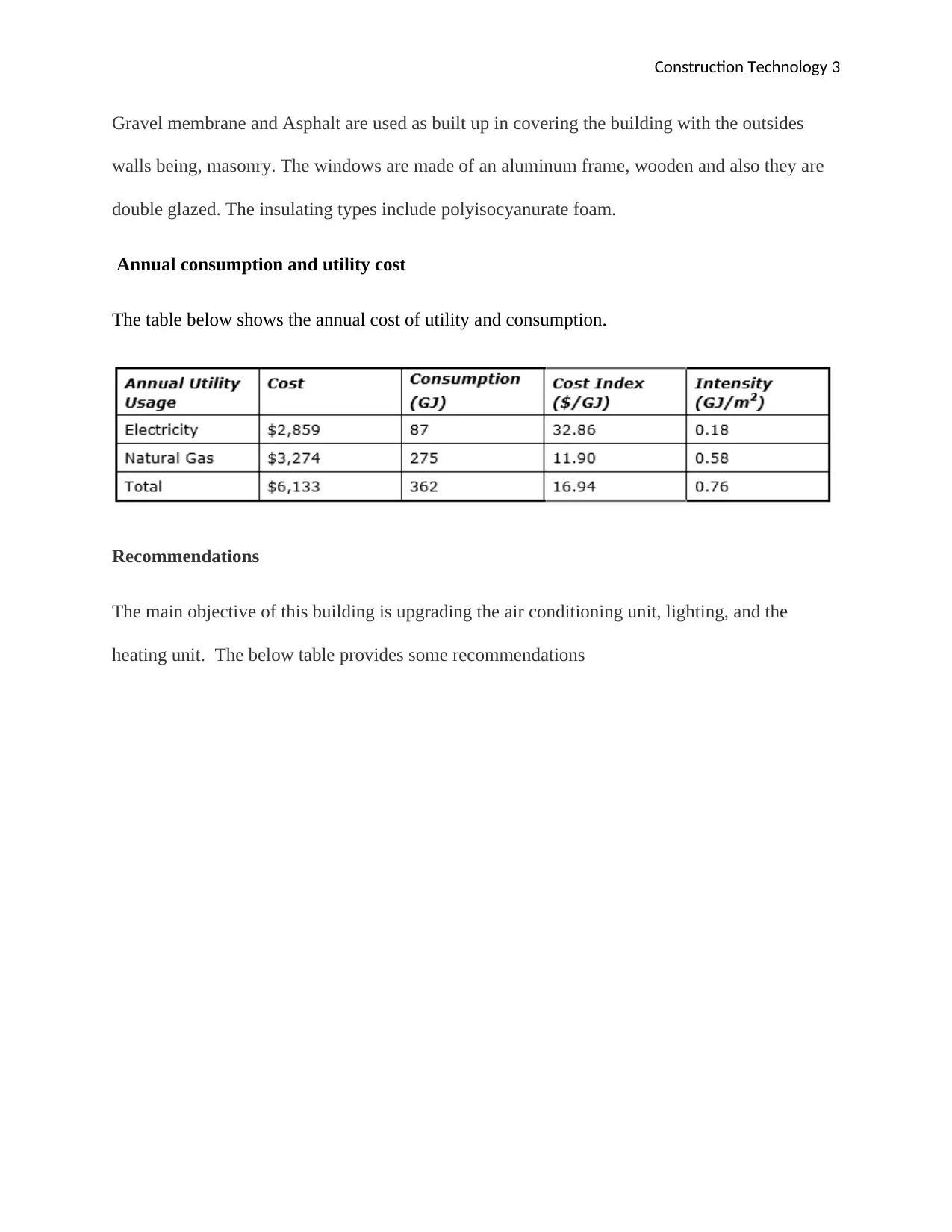
Construction Technology 3
Gravel membrane and Asphalt are used as built up in covering the building with the outsides
walls being, masonry. The windows are made of an aluminum frame, wooden and also they are
double glazed. The insulating types include polyisocyanurate foam.
Annual consumption and utility cost
The table below shows the annual cost of utility and consumption.
Recommendations
The main objective of this building is upgrading the air conditioning unit, lighting, and the
heating unit. The below table provides some recommendations
Gravel membrane and Asphalt are used as built up in covering the building with the outsides
walls being, masonry. The windows are made of an aluminum frame, wooden and also they are
double glazed. The insulating types include polyisocyanurate foam.
Annual consumption and utility cost
The table below shows the annual cost of utility and consumption.
Recommendations
The main objective of this building is upgrading the air conditioning unit, lighting, and the
heating unit. The below table provides some recommendations
⊘ This is a preview!⊘
Do you want full access?
Subscribe today to unlock all pages.

Trusted by 1+ million students worldwide
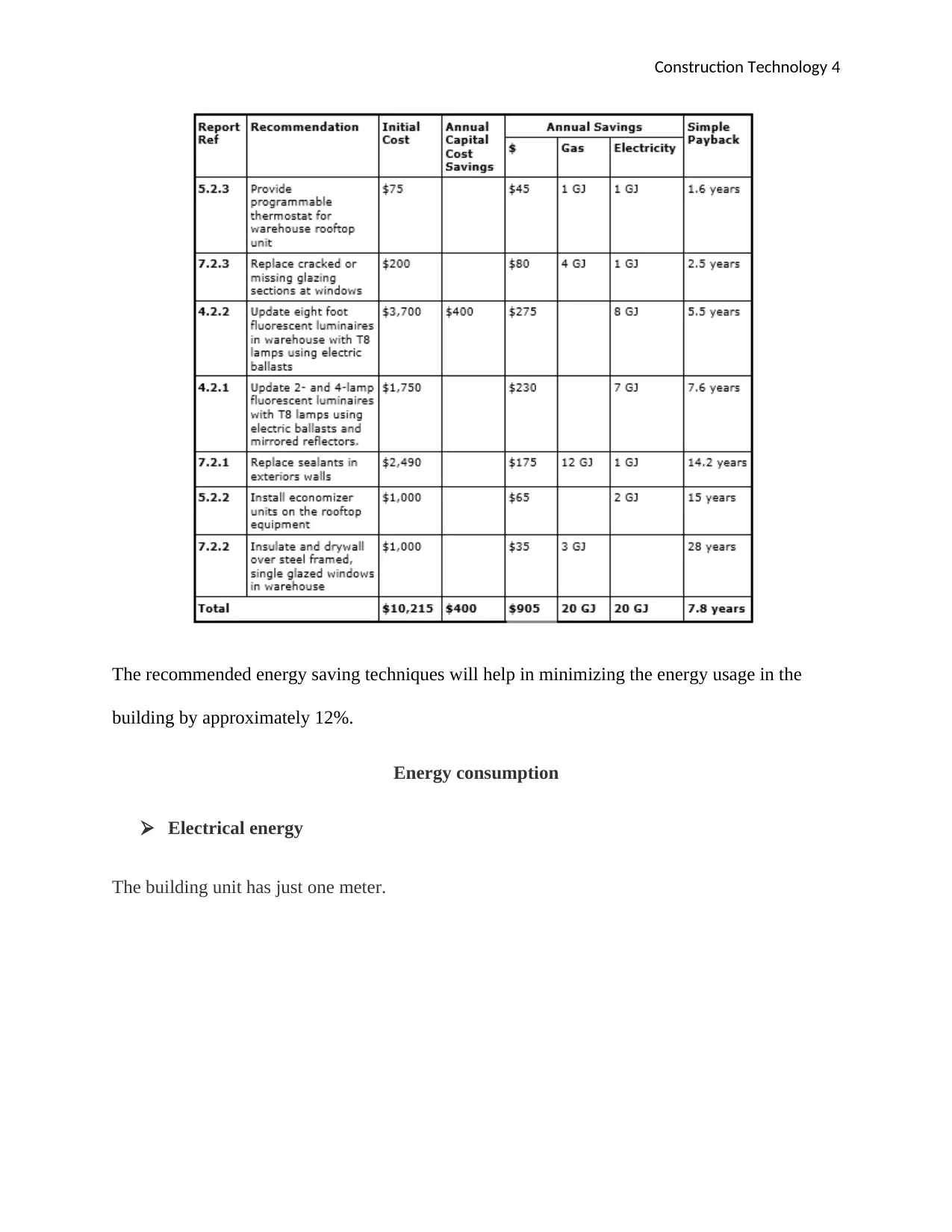
Construction Technology 4
The recommended energy saving techniques will help in minimizing the energy usage in the
building by approximately 12%.
Energy consumption
Electrical energy
The building unit has just one meter.
The recommended energy saving techniques will help in minimizing the energy usage in the
building by approximately 12%.
Energy consumption
Electrical energy
The building unit has just one meter.
Paraphrase This Document
Need a fresh take? Get an instant paraphrase of this document with our AI Paraphraser
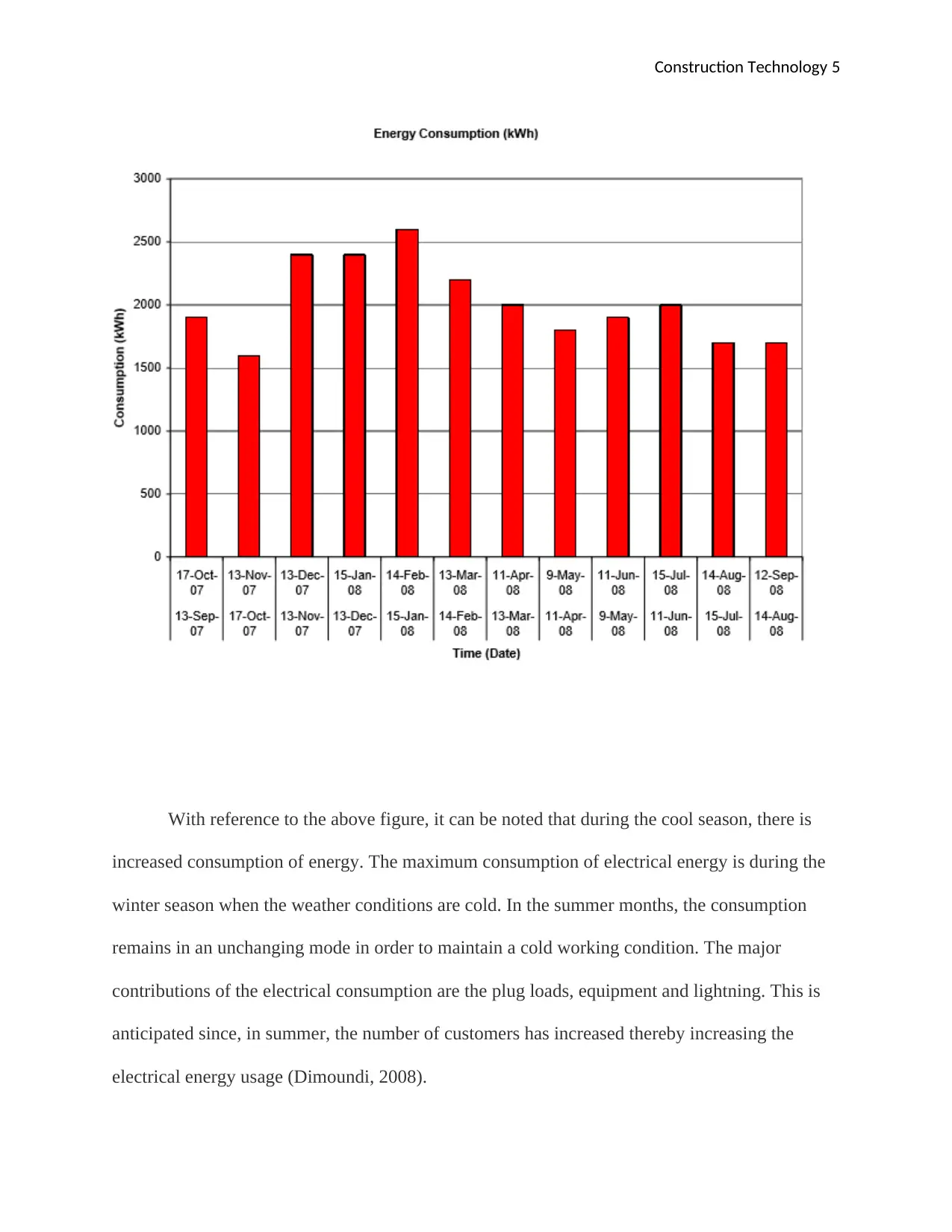
Construction Technology 5
With reference to the above figure, it can be noted that during the cool season, there is
increased consumption of energy. The maximum consumption of electrical energy is during the
winter season when the weather conditions are cold. In the summer months, the consumption
remains in an unchanging mode in order to maintain a cold working condition. The major
contributions of the electrical consumption are the plug loads, equipment and lightning. This is
anticipated since, in summer, the number of customers has increased thereby increasing the
electrical energy usage (Dimoundi, 2008).
With reference to the above figure, it can be noted that during the cool season, there is
increased consumption of energy. The maximum consumption of electrical energy is during the
winter season when the weather conditions are cold. In the summer months, the consumption
remains in an unchanging mode in order to maintain a cold working condition. The major
contributions of the electrical consumption are the plug loads, equipment and lightning. This is
anticipated since, in summer, the number of customers has increased thereby increasing the
electrical energy usage (Dimoundi, 2008).
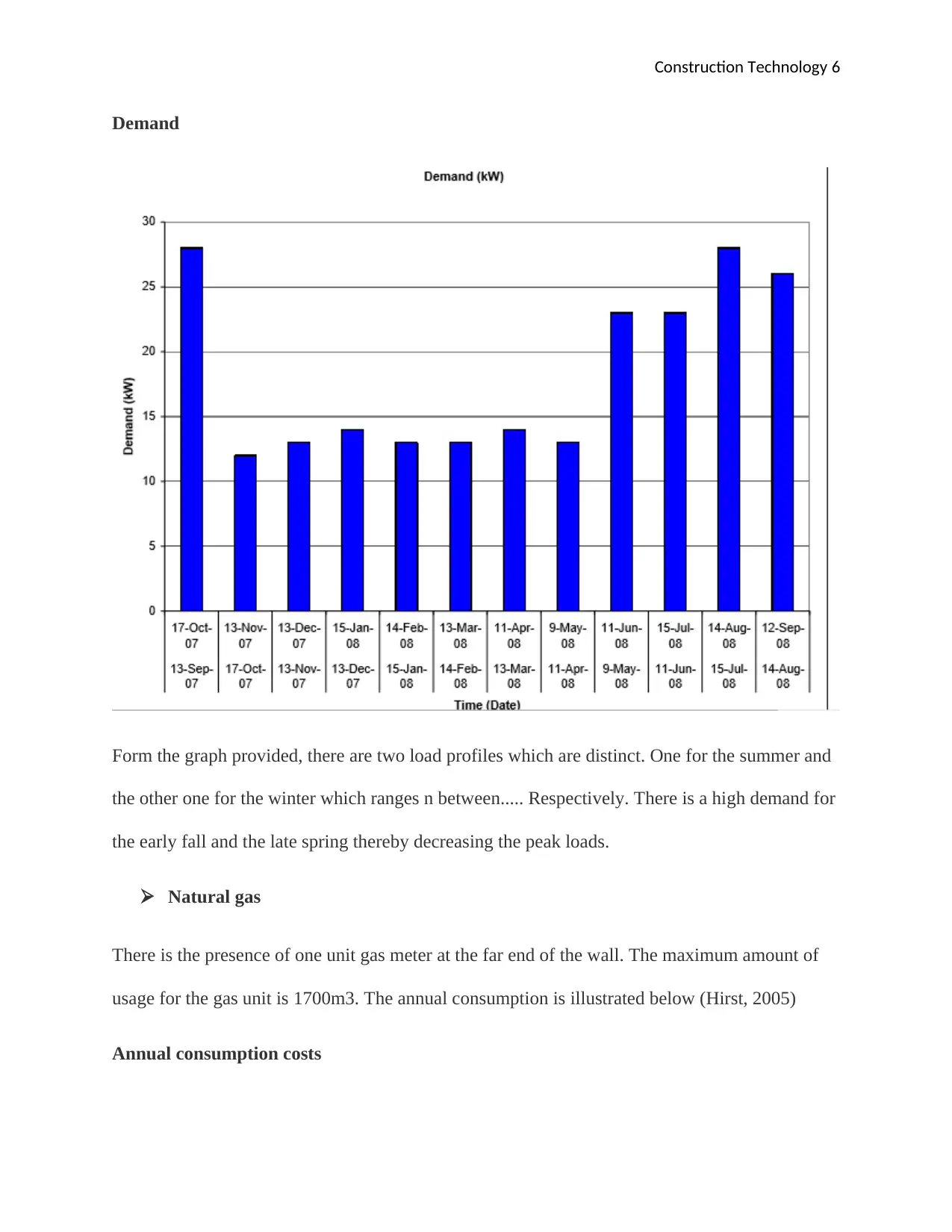
Construction Technology 6
Demand
Form the graph provided, there are two load profiles which are distinct. One for the summer and
the other one for the winter which ranges n between..... Respectively. There is a high demand for
the early fall and the late spring thereby decreasing the peak loads.
Natural gas
There is the presence of one unit gas meter at the far end of the wall. The maximum amount of
usage for the gas unit is 1700m3. The annual consumption is illustrated below (Hirst, 2005)
Annual consumption costs
Demand
Form the graph provided, there are two load profiles which are distinct. One for the summer and
the other one for the winter which ranges n between..... Respectively. There is a high demand for
the early fall and the late spring thereby decreasing the peak loads.
Natural gas
There is the presence of one unit gas meter at the far end of the wall. The maximum amount of
usage for the gas unit is 1700m3. The annual consumption is illustrated below (Hirst, 2005)
Annual consumption costs
⊘ This is a preview!⊘
Do you want full access?
Subscribe today to unlock all pages.

Trusted by 1+ million students worldwide
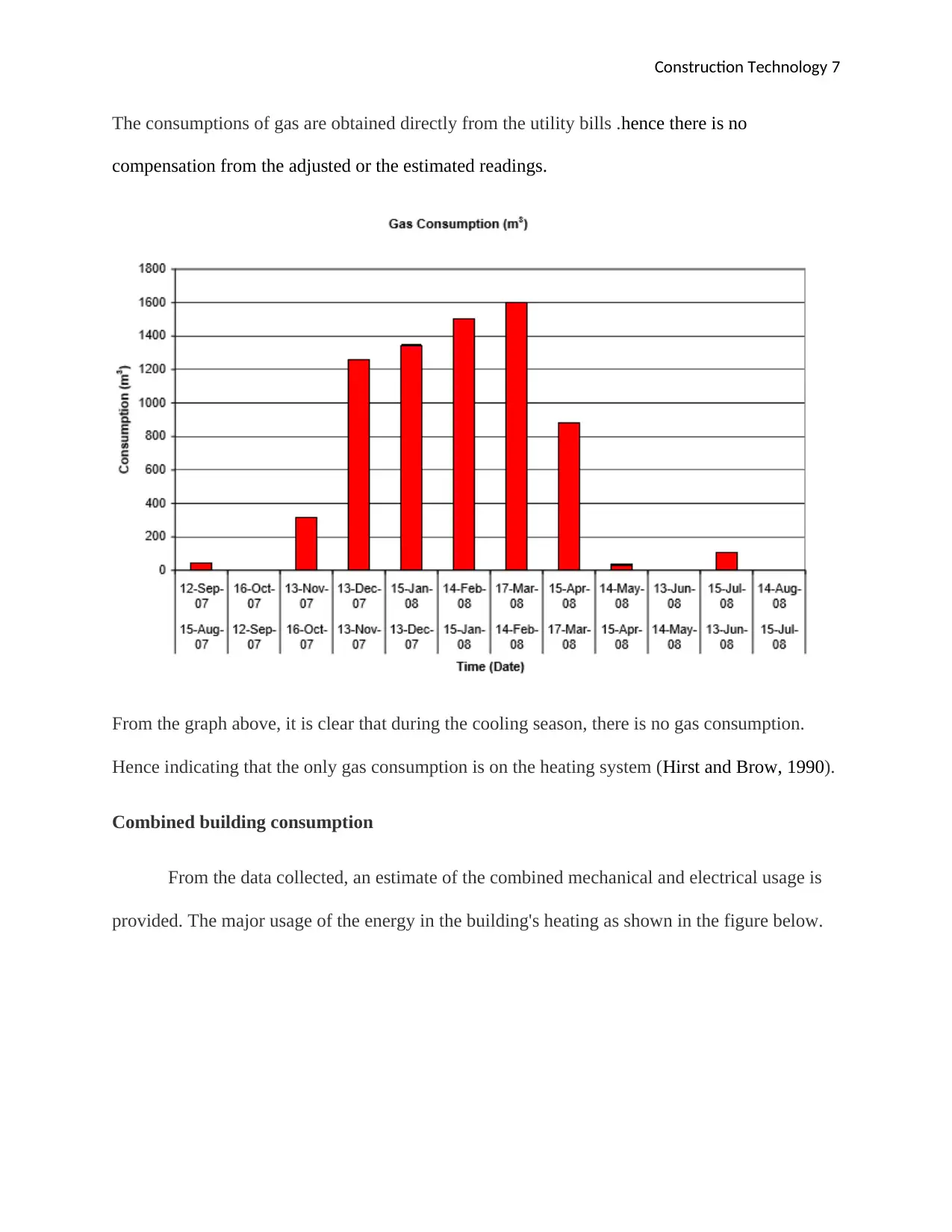
Construction Technology 7
The consumptions of gas are obtained directly from the utility bills .hence there is no
compensation from the adjusted or the estimated readings.
From the graph above, it is clear that during the cooling season, there is no gas consumption.
Hence indicating that the only gas consumption is on the heating system (Hirst and Brow, 1990).
Combined building consumption
From the data collected, an estimate of the combined mechanical and electrical usage is
provided. The major usage of the energy in the building's heating as shown in the figure below.
The consumptions of gas are obtained directly from the utility bills .hence there is no
compensation from the adjusted or the estimated readings.
From the graph above, it is clear that during the cooling season, there is no gas consumption.
Hence indicating that the only gas consumption is on the heating system (Hirst and Brow, 1990).
Combined building consumption
From the data collected, an estimate of the combined mechanical and electrical usage is
provided. The major usage of the energy in the building's heating as shown in the figure below.
Paraphrase This Document
Need a fresh take? Get an instant paraphrase of this document with our AI Paraphraser
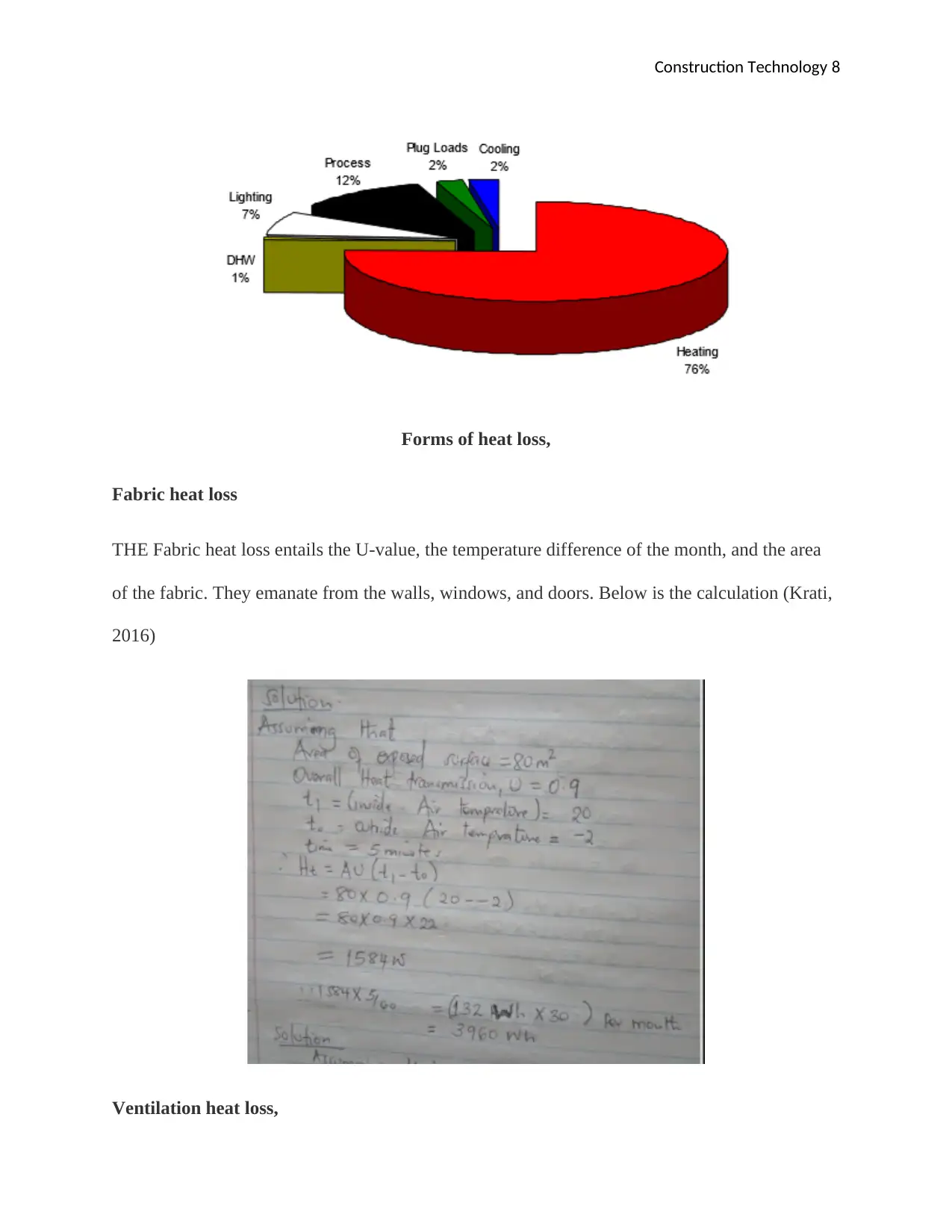
Construction Technology 8
Forms of heat loss,
Fabric heat loss
THE Fabric heat loss entails the U-value, the temperature difference of the month, and the area
of the fabric. They emanate from the walls, windows, and doors. Below is the calculation (Krati,
2016)
Ventilation heat loss,
Forms of heat loss,
Fabric heat loss
THE Fabric heat loss entails the U-value, the temperature difference of the month, and the area
of the fabric. They emanate from the walls, windows, and doors. Below is the calculation (Krati,
2016)
Ventilation heat loss,
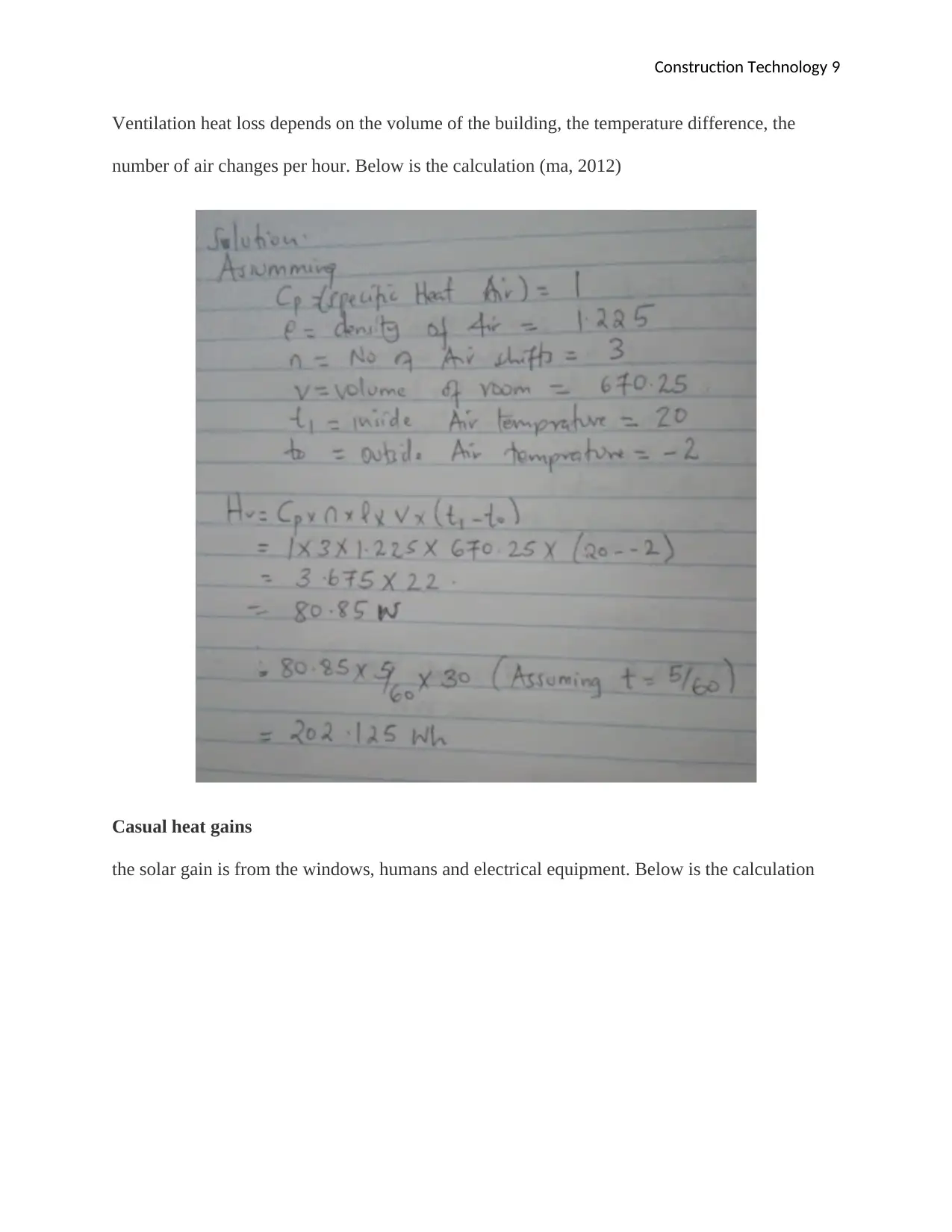
Construction Technology 9
Ventilation heat loss depends on the volume of the building, the temperature difference, the
number of air changes per hour. Below is the calculation (ma, 2012)
Casual heat gains
the solar gain is from the windows, humans and electrical equipment. Below is the calculation
Ventilation heat loss depends on the volume of the building, the temperature difference, the
number of air changes per hour. Below is the calculation (ma, 2012)
Casual heat gains
the solar gain is from the windows, humans and electrical equipment. Below is the calculation
⊘ This is a preview!⊘
Do you want full access?
Subscribe today to unlock all pages.

Trusted by 1+ million students worldwide
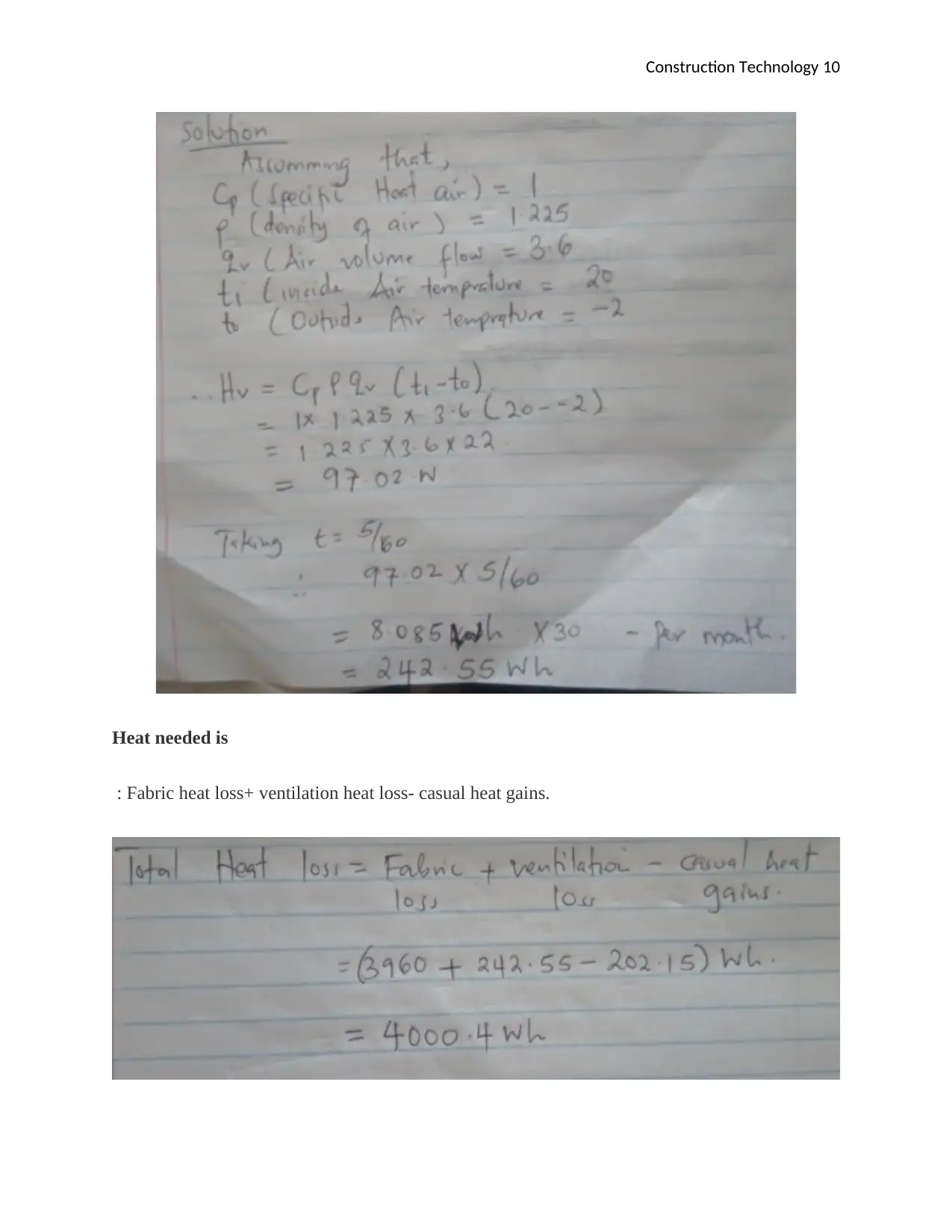
Construction Technology 10
Heat needed is
: Fabric heat loss+ ventilation heat loss- casual heat gains.
Heat needed is
: Fabric heat loss+ ventilation heat loss- casual heat gains.
Paraphrase This Document
Need a fresh take? Get an instant paraphrase of this document with our AI Paraphraser
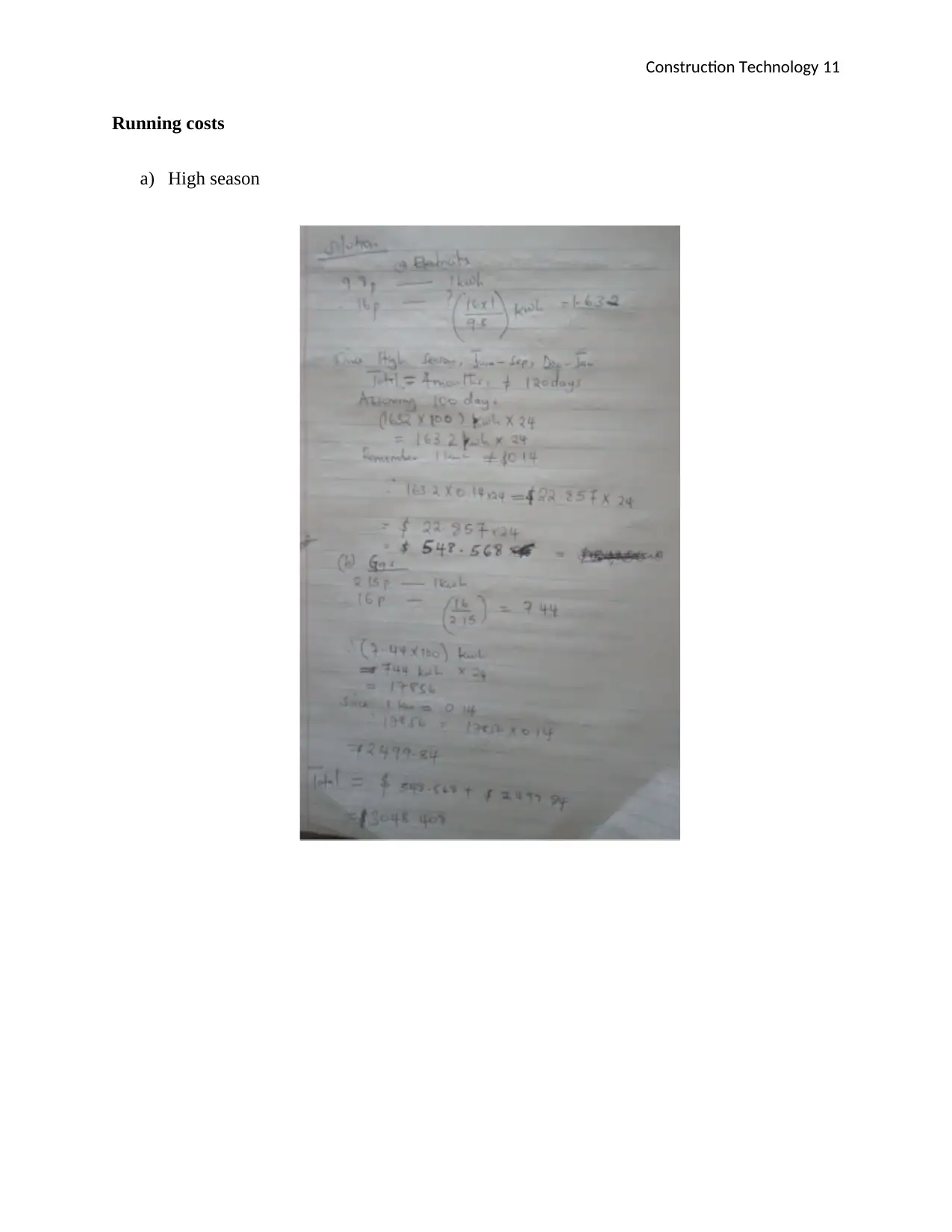
Construction Technology 11
Running costs
a) High season
Running costs
a) High season
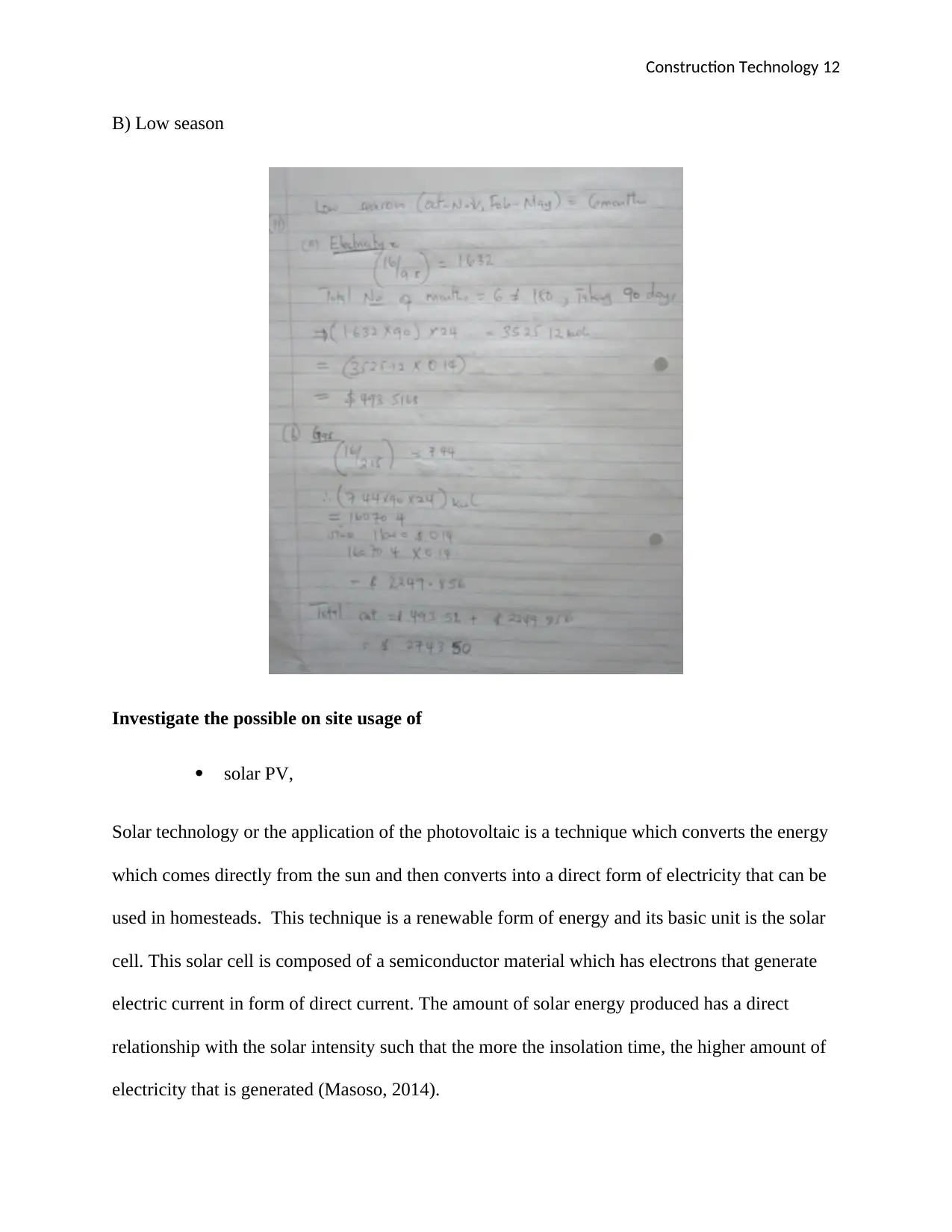
Construction Technology 12
B) Low season
Investigate the possible on site usage of
solar PV,
Solar technology or the application of the photovoltaic is a technique which converts the energy
which comes directly from the sun and then converts into a direct form of electricity that can be
used in homesteads. This technique is a renewable form of energy and its basic unit is the solar
cell. This solar cell is composed of a semiconductor material which has electrons that generate
electric current in form of direct current. The amount of solar energy produced has a direct
relationship with the solar intensity such that the more the insolation time, the higher amount of
electricity that is generated (Masoso, 2014).
B) Low season
Investigate the possible on site usage of
solar PV,
Solar technology or the application of the photovoltaic is a technique which converts the energy
which comes directly from the sun and then converts into a direct form of electricity that can be
used in homesteads. This technique is a renewable form of energy and its basic unit is the solar
cell. This solar cell is composed of a semiconductor material which has electrons that generate
electric current in form of direct current. The amount of solar energy produced has a direct
relationship with the solar intensity such that the more the insolation time, the higher amount of
electricity that is generated (Masoso, 2014).
⊘ This is a preview!⊘
Do you want full access?
Subscribe today to unlock all pages.

Trusted by 1+ million students worldwide
1 out of 19
Related Documents
Your All-in-One AI-Powered Toolkit for Academic Success.
+13062052269
info@desklib.com
Available 24*7 on WhatsApp / Email
![[object Object]](/_next/static/media/star-bottom.7253800d.svg)
Unlock your academic potential
Copyright © 2020–2025 A2Z Services. All Rights Reserved. Developed and managed by ZUCOL.




